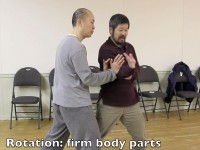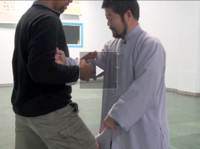 The key to taiji movements is first of all ROTATION. But how can we rotate when we have two feet, two legs, etc.? In this video, Master Chen Zhonghua shows one aspect of rotational movement requirements: the body must be firm to form a structure conducive to a rotation. Presenter: Chen Zhonghua Length: 12 min. In: English Year: 2013 Difficulty:4/5 At:Maple Ridge, B.C. Canada
The key to taiji movements is first of all ROTATION. But how can we rotate when we have two feet, two legs, etc.? In this video, Master Chen Zhonghua shows one aspect of rotational movement requirements: the body must be firm to form a structure conducive to a rotation. Presenter: Chen Zhonghua Length: 12 min. In: English Year: 2013 Difficulty:4/5 At:Maple Ridge, B.C. Canada
“Rotation: Firm Body” Online Video Purchase
Previous post: Lines and Weight of Swordplay
Next post: May, 2013 Daqingshan Institute of Chinese Classics Lectures Series



{ 10 comments… read them below or add one }
Master Chen told us in Phoenix, ” when you begin learning Taiji, if you practice the Yilu very ‘stiff’, you greatly increase your chances of developing real ability “…. now I know why he said it, so we can learn how to rotate!
Yes, strictly follow Master Chen’s teaching, no need to contemplating. Any attempt to interpret his words only adds a layer of confusion.
Quite often, people mistakenly think coiling is rotating.
Pingwei, it is always very informative to read your perspectives on various issues, such as drills and practices, at this site. With respect to coiling vs rotating, can you elaborate a bit more? I do not know the difference between the two unless “coiling” is seen as rotation with displacement. Is that what you are hinting?
In Master Chen’s above video, he used rubber as an example. One end of a rubber cord is fixed, you hold the other end and do an “rotating” move. Because the rubber is soft and flexible, the end result of that move is that the rubber is coiling.
If you can find somebody who does Yang style Tai Chi, show him our “twisting towel” move, then let him do it while hold his hands and give a little resistance, he will most likely do “coiling” instead of “rotating.” You can feel it.
Coiling is coiling and rotating is rotating.
To coil is to loop or circle around an object; in order to wrap around the object. When Yang Style TaichiQuan talks about coiling, they refer to moving your surface of contact into more advantageous positions. Your surface of contact is often the hands, and sometimes you need to loop/coil your around your opponent’s surface of contact to obtain a more advantageous position.
Rotating is having a center that does not displace but spins around a point/axis. so when the center spins, the exterior displaces. Rotating our bodies is a way to produce force without the center displacing is space. Force is mass times acceleration. In linear acceleration, the body displaces and creates linear momentum. In angular acceleration, the body does not displace but spins around a point/axis and creates angular force.
I agree that people often mistake coiling for “song” waist(松腰). I think we need the waist as a strong shaft to neutralize incoming force. If our waist can stay in position as we refer to “no move” for strong incoming force and it can still rotate smoothly then it is the real “song” waist.
You already described “don’t move the waist”, “rotate it”. Then there is no need to use the word “song”, is there?
Thank you Master Chen. I get it. As the word “song” can have too many meanings which need to be avoided in understanding the action itself not the word. I find out in circle exercise that the spine does not move. The waist rotate around the spine like the merry-go-round fixed on the bearing but the central shaft is fixed on the ground. I think perhaps the spine and the waist should be separated so that waist can rotate.
It seems to me that the notion of softly coiling, often associated, with Taiji is tied to the intention of avoiding or attempting to “run” around the opponents power, whereas Master Chen’s taiji teaches us a method to use the point of contact as part of a system to “connect” further to the opponent and go “through” instead of “away from” or “around”.
“Toronto 2-2” details very clearly how stiffness/rigidity is used as a method to learn to connect and align the body to gradually add in more of our individual body parts, that ultimately contribute and connect back to the waist rotation. It deals particularly with the “twisting the towel” exercise that Pingwei refers to and gives a tip on a great “special device” to help the process along. My wife will be wondering what happened to our broom handle…… :-0
http://practicalmethod.com/2012/10/toront-2-2-online-video-trailer/